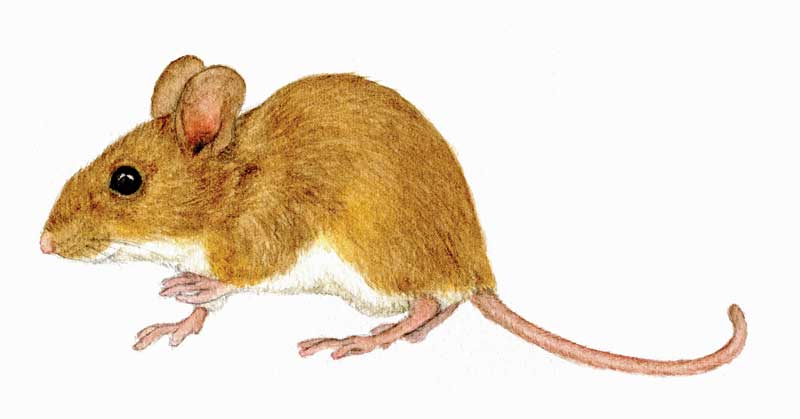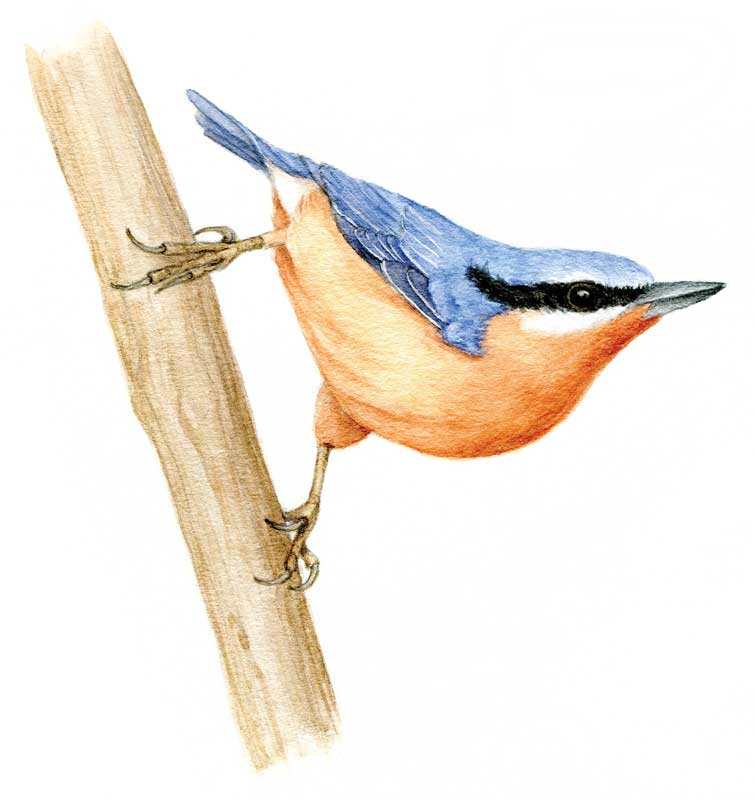And it’s a warm light—snow melts off the roof,
The first lambs are born in the barn cellar,
The hens start laying, the mare comes into season…
Oh warm light, couldn’t you have waited a little longer?
How safe we were in the dead of winter; how gently we dreamed,
How beautiful it was to sleep under the snow!”
—Kate Barnes
Dear Friends:
As the snow accumulates, most critters stay denned up. Deer struggle through deeper drifts while small mammals burrow through the snow looking for a meal. Over-wintering songbirds hide away in heavy brush cover as the blizzards rage, and then come swooping and twittering out when things calm down. Finches and chickadees chatter and flit gaily above, lifting the spirits of the poor, wingless, furless, joyless mammals grimly shoveling snow below: “Look up and see us darting under pale skies, tiny downy bundles of life, ever cheerful, ever chirping, ever up for the next meal.”
 Illustration by Candice HutchisonField and forest report, January
Illustration by Candice HutchisonField and forest report, January
Maine is home to an astonishing number of small rodents including the North American deer mouse, the white-footed deer mouse, the meadow jumping mouse, and the woodland jumping mouse, as well as meadow, southern, red-backed, rock, and woodland voles, and the southern and northern bog lemmings. The deer mouse is probably the most common of what we call “field mice” and the Passamaquoddy call Tuhkis. Mice do not hibernate, and though the deep snow of a Maine winter can be hard on all wildlife, it offers these tiny creatures a certain advantage. They make long tunnels under the snow and are able to forage far and wide even in broad daylight without being seen by the sharp-eyed hawk Kuwhas, the wily fox Qaqsoss, or the cunning coyote Pilimalsom.
 Illustration by Candice HutchisonWatching the birdfeeder the other day, I was delighted to see a field mouse pop out of its tunnel in the snow to fill its cheeks with sunflower seeds and disappear again. Field mice live in burrows lined with soft insulating material such as milkweed fluff, shredded birch bark, and crumbled leaves—nice and cozy. But they must eat almost constantly, especially when it is cold, because their metabolism is very high. Field mice benefit the natural economy in numerous ways. They carry seeds far and wide helping to propagate many species. They loosen, aerate, and improve heavy soils with their burrows filled with shredded organic matter. And, of course, they feed so many larger carnivores that field mice may be aptly called the McNuggets of the wild.
Illustration by Candice HutchisonWatching the birdfeeder the other day, I was delighted to see a field mouse pop out of its tunnel in the snow to fill its cheeks with sunflower seeds and disappear again. Field mice live in burrows lined with soft insulating material such as milkweed fluff, shredded birch bark, and crumbled leaves—nice and cozy. But they must eat almost constantly, especially when it is cold, because their metabolism is very high. Field mice benefit the natural economy in numerous ways. They carry seeds far and wide helping to propagate many species. They loosen, aerate, and improve heavy soils with their burrows filled with shredded organic matter. And, of course, they feed so many larger carnivores that field mice may be aptly called the McNuggets of the wild.
Natural events
The old timers used to say a good winter was one that would “get cold and stay cold” and your commentator—being an old-timer himself now—can remember plenty of winters that did just that. Why, I remember back in ’78… Oh well, never mind. But in recent years we have seen more and more winters that get cold, then get warm, then get cold again. These are rock-splitting, mountain-smashing winters. “How so?” you say: By the power of water which, unlike other liquids, expands when it freezes. The freeze/thaw cycle allows water to soak into the tiniest cracks when it is warm and then swell and push against the rock with a mighty hydraulic power when it freezes. Over eons of time, massive rocks are split and majestic mountains are pulverized by this process.
One well-known “Split Rock” is on Passamaquoddy Bay at Sipayik and it has been a communal gathering place for ages. There are many others scattered throughout the woods and along the shores. The Alleghenys, the Appalachians, the mountains of New England, and of course Awanadjo herself are all remnants of much larger mountains smashed by ice in winter and washed away by rain in spring and summer down to little nubbins that hardly look like mountains at all. The sand and silt that came from these mountains have washed out to sea to settle and be recast into stone over eons, then to be heaved up again by the endless tectonic action of the earth.
Saltwater report
To see the full power of water against rock go to the coast at a place like West Quoddy Head and see how the relentless work of the softest medium has sculpted and smoothed and hollowed out the hardest with patience and persistence.
Natural events, February
Watching the crows huddled on a windy branch, or the deer looking for something to browse on a bitter day, or the nuthatches and chickadees chirping valiantly in the cold, it would take a hard heart not to wonder how they are feeling through the bleak midwinter. Probably, very few connoisseurs of this column would say these creatures had no feelings at all. And yet, that was the prevailing scientific view in Western culture for generations: that animals had no feelings, no thoughts, no affections, no sense of self, no language or tools or techniques, nor anything close to human intelligence.
“They eat without pleasure, cry without pain, grow without knowing it, they desire nothing, fear nothing, know nothing,” wrote Nicolas Malebranche, the 17th century philosopher and student of Descartes, expressing the rationalist position. Call it the hard-headed view. And yet, tribal people, woods-wanderers, shepherds, farmers, poets, and lovers of nature since the dawn of time have known animals to have feelings, thoughts, affections, a degree of personality, and something to teach us if we will heed them. Call this the soft-hearted view.
In our own times, an epochal change is now under way whereby the hard heads and the soft hearts are coming together to acknowledge that other creatures have feelings and abilities like our own and even beyond our own. Scientists are showing that whales sing, primates use language, crows are highly social and can recognize human faces, octopi show emotions, monkeys practice morality, and birds teach their young, among many other wonders. Squirrels and blue jays can remember the locations of hundreds of acorns they have cached over large areas, and we can’t even remember where we left our keys.
For more on these marvels, see Are We Smart Enough to Know How Smart Animals Are? by the Dutch ethologist Frans de Waal of Emory University.
Field and forest report
Fields are now covered in deep snow with sculpted drifts that follow the sweeping flow of wind currents around trees, ledges and old stone walls. Deer leap in great arcs through the drifts with white tails high, throwing plumes of snow silently behind them. Snowshoe hare forage far afield, leaving their exclamatory trails from cover to cover, looking for juicy bark to gnaw. On warmer nights, the pungent perfume of prowling skunks wafts on the breezes as they seek out mates for the coming season.
Rank opinion
We humans tend to give animals personal qualities. We say that the fox is sly, the hare is timid, the red squirrel is nervous and territorial, the coyote is intelligent and tricky. Some would say that this
is giving human qualities to animals unduly. But, I say that personal qualities are present in all Nature, not just human nature. Nature is personal. I have seen animals grieve, remember, think, play, and perform rituals, and am convinced that personhood is a quality of all flesh. We are not alone in our joys and sorrows, our mourning and dancing, our suffering and our playing. We are not isolated and alone, but members of the family of Creation.
I wonder what qualities other creatures—if we could understand them—might attribute to us. They might say that we have intelligence, craft, language, territoriality, building skills, powers of propagation that make rabbits look like amateurs, and a terrible gift for killing. Have you ever said to some frightened creature fleeing from you, “Don’t be afraid; I won’t hurt you”? But surely their fright is not irrational. They know that the ways of our kind have been the death of too many of theirs.
Natural events, late-February
Watching the eagle soar along the rocky shore or the deer leap and run through the fields or the snowshoe hare walk upon the snow we ask, “Could they possibly be more elegantly evolved, more intelligently designed, more perfectly adapted to fit their surroundings, to enhance their environment, to thrive in the land where they dwell?” The answer is, “Yes, they could.” And that is exactly what they are doing at this very moment and every moment as they play and feed and flee. Each generation of eagle or deer or hare is slightly more adapted to their surroundings, more tuned to their environment, more likely to thrive where they dwell.
And so it is with us. Every human generation is better adapted to their surroundings and more evolved to live in the land where they dwell. We belong here, and as the years go by we will belong here even more.
Seedpod to carry around with you
From Frances W. Wile, 1878-1939: “All beautiful the march of days as seasons come and go; the hand that shaped the rose hath wrought the crystal of the snow, hath sent the hoary frost of heaven, the flowing waters sealed, and laid a silent loveliness on hill and wood and field.”
That’s the Almanack for this time. But don’t take it from us—we’re no experts. Go out and see for yourself.
Yr. mst. humble & obd’nt servant,
Rob McCall.
Rob McCall lives way downeast on Moose Island and also spends time at his Eggemoggin Field Station.. This almanack is excerpted from his weekly radio show, heard on WERU FM (89.9 in Blue Hill, 99.9 in Bangor) and streamed live via www.weru.org. Reach Rob via email at awanadjoalmanack@gmail.com.






